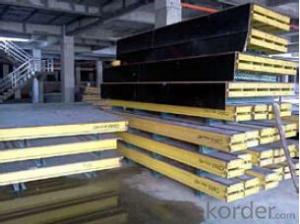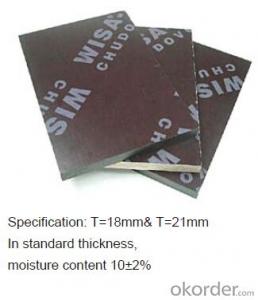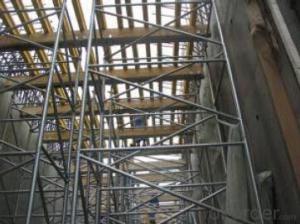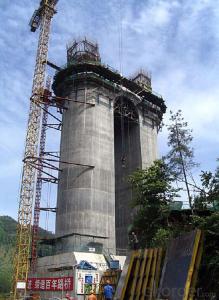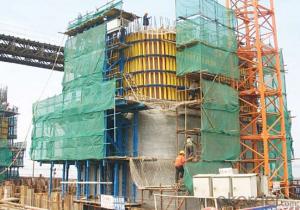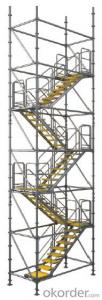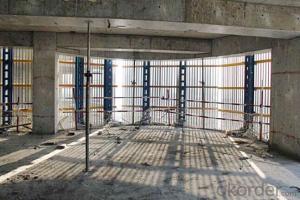Plywood-Formwork system for Formwork and Scaffolding
- Loading Port:
- Tianjin
- Payment Terms:
- TT OR LC
- Min Order Qty:
- 50 m²
- Supply Capability:
- 1000 m²/month
OKorder Service Pledge
Quality Product, Order Online Tracking, Timely Delivery
OKorder Financial Service
Credit Rating, Credit Services, Credit Purchasing
You Might Also Like
Plywood --- make perfect concrete surface
WISA-Form Birch is a coated special plywood using in the formwork systems where high
requirements are set on the concrete surface and the times of reuses.
With CNBM timber beam & WISA plywood, the formwork is low weight but high load capacity, it is
widely used in construction.
Characteristics:
◆ Component with high standardization.
◆ Assembling in site, flexible application.
◆ Light weight, easy transportation and storage.
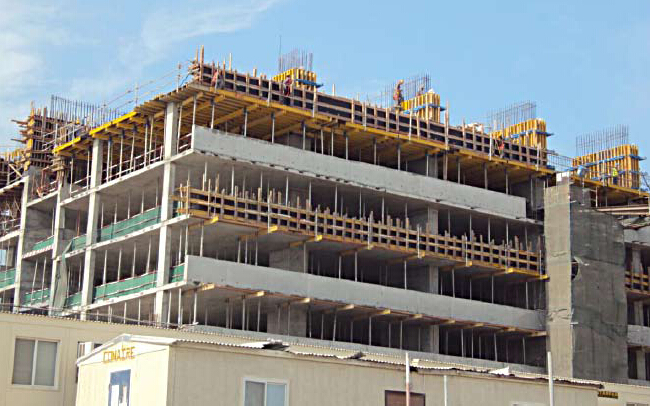
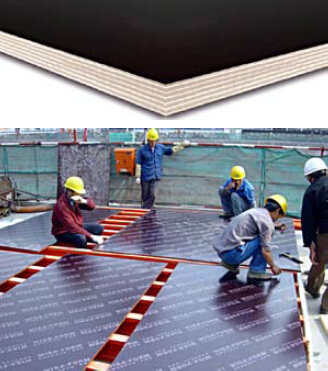
- Q: What are the different types of steel formwork systems available?
- There are several different types of steel formwork systems available, including traditional steel formwork, modular steel formwork, and tunnel formwork. Traditional steel formwork consists of steel panels and supports that are assembled on-site to create the desired formwork structure. Modular steel formwork, on the other hand, is pre-assembled in a factory and can be easily transported and installed. Lastly, tunnel formwork is a specialized type of steel formwork used for constructing tunnels, where the formwork is moved forward as the tunnel progresses.
- Q: What are the considerations for designing steel formwork systems?
- Some considerations for designing steel formwork systems include the load-bearing capacity of the steel, the desired shape and size of the forms, the ease of assembly and disassembly, the compatibility with other construction methods, the cost-effectiveness, and the durability of the materials used. Additionally, factors such as the required finishes, the need for reusability, and the safety precautions should also be taken into account during the design process.
- Q: How does steel formwork contribute to the overall stability of the structure?
- There are several ways in which steel formwork contributes to the overall stability of a structure. Firstly, steel is a highly durable and strong material, enabling it to withstand significant loads and pressures. This strength ensures that the formwork remains intact and stable throughout the construction process, even when exposed to heavy loads such as wet concrete. Furthermore, steel formwork offers excellent dimensional stability, unlike materials like wood that may warp or deform over time. This ensures that the structure retains its desired shape and dimensions, which is crucial for stability. Any deformation or movement in the formwork could lead to inaccuracies or weaknesses in the final construction. In addition, steel formwork provides a high level of rigidity and stiffness. This rigidity prevents unwanted movement or shifting of the formwork during concrete pouring and curing, ensuring that the structure adheres to the intended design and specifications. It also evenly distributes weight and forces, reducing the risk of structural failures. Moreover, steel formwork provides exceptional support and reinforcement for the concrete. The steel panels and beams used in formwork act as a framework, holding the concrete in place until it hardens and gains its own strength. This support guarantees the proper formation of the structure and prevents concrete cracking or failure, further enhancing overall stability. Lastly, steel formwork is incredibly adaptable and can be easily customized to fit various architectural designs and construction requirements. This flexibility allows for the creation of complex and unique structures while maintaining stability and strength. In conclusion, steel formwork significantly contributes to the overall stability of a structure through its durability, dimensional stability, rigidity, support, and adaptability. Its robustness, ability to withstand heavy loads, and capability to maintain shape and provide structural support make it a vital component in ensuring the stability and integrity of any construction project.
- Q: What are the common safety guidelines when working with steel formwork in hazardous areas?
- When working with steel formwork in hazardous areas, it is important to follow some common safety guidelines. These include wearing appropriate personal protective equipment (PPE) such as safety goggles, gloves, and steel-toed boots to protect against potential hazards. Additionally, workers should ensure that the steel formwork is properly installed and secured to prevent any accidents or collapses. It is also essential to be aware of the weight and load capacity of the formwork to avoid overloading and potential structural failures. Regular inspections and maintenance of the formwork are necessary to identify any defects or weaknesses that could compromise safety. Lastly, workers should be trained on emergency procedures and know the location of emergency exits and evacuation routes in case of any unforeseen incidents.
- Q: What are the different types of lifting systems used in steel formwork?
- There are several types of lifting systems used in steel formwork, including manual lifting systems, mechanical lifting systems, and hydraulic lifting systems. Manual lifting systems involve the use of manual labor and equipment, such as cranes or hoists, to lift and move the steel formwork. Mechanical lifting systems utilize mechanical devices, such as electric winches or chain blocks, to lift and transport the formwork. Hydraulic lifting systems utilize hydraulic power to lift and lower the steel formwork, providing greater control and precision in the lifting process.
- Q: What are the considerations when designing steel formwork for retaining walls?
- When it comes to designing steel formwork for retaining walls, it is crucial to take several important factors into account: 1. Structural stability is of utmost importance. The steel formwork must be able to withstand the lateral pressure exerted by the retained material. To achieve this, it is essential to incorporate adequate thickness, reinforcement, and bracing. 2. The formwork should also have the necessary load capacity to support the weight of the concrete and any additional loads during construction. It should be able to withstand these loads without any deformation or failure. 3. Durability is another key consideration. Retaining walls are exposed to various environmental conditions, so the steel formwork must be designed to resist corrosion, rust, and other forms of deterioration. This can be achieved by using corrosion-resistant steel or applying protective coatings. 4. The design should also prioritize ease of construction. The steel formwork should be structurally sound yet easy to install and remove. This will save time and labor during construction. 5. Flexibility is essential as retaining walls can have different geometries and dimensions. The steel formwork should be flexible enough to accommodate these variations. Adjustable connections or modular components can be used to achieve this flexibility. 6. Safety is of utmost importance. Proper consideration should be given to fall protection, access, and working platforms to ensure the safety of workers during construction. 7. Lastly, cost-effectiveness should be optimized. The design should minimize material usage and labor costs while still meeting the required strength and durability. Standard sizes and components, as well as reusable elements, can help achieve this goal. By considering these factors, designers can ensure that the steel formwork for retaining walls is not only structurally sound and durable but also efficient and cost-effective.
- Q: Can steel formwork be customized to specific project requirements?
- Steel formwork has the capability to be tailored according to the specific needs of a project. The versatility of steel as a material allows it to be easily shaped and crafted to meet the precise dimensions, shapes, and designs required for a particular project. As a result, intricate and distinctive formwork structures can be created, enabling the pouring of concrete in diverse sizes and shapes. Moreover, steel formwork can be modified and adjusted throughout the construction phase to accommodate any necessary modifications or alterations. The adaptability and flexibility of steel formwork render it a perfect option for projects that call for precise and personalized requirements.
- Q: How does steel formwork handle different types of concrete mixes?
- Steel formwork is highly versatile and can handle different types of concrete mixes effectively. Its strength and durability make it suitable for various concrete compositions, including lightweight, normal, or high-strength mixes. Steel formwork provides a rigid structure that can withstand the pressure exerted by the concrete during pouring and setting. Additionally, its smooth surface allows for easy removal and produces a high-quality finish on the concrete surface. Overall, steel formwork is a reliable choice for accommodating different types of concrete mixes in construction projects.
- Q: How does steel formwork affect the schedule of a construction project?
- Steel formwork can have a significant impact on the schedule of a construction project. One of the main advantages of using steel formwork is its durability and reusability. Unlike traditional wood formwork, steel formwork can be used multiple times, resulting in faster construction cycles. This means that the formwork can be easily dismantled and reassembled at different parts of the project, allowing for concurrent construction activities and ultimately reducing the overall construction time. Additionally, steel formwork provides better dimensional control and accuracy, ensuring that the concrete structures are built according to the specified designs. This reduces the need for rework or corrections, which can further save time and resources. Furthermore, steel formwork is known for its strength and stability, which enables it to withstand the pressure exerted by the concrete during pouring and curing. This allows for faster pouring and curing times, as well as the ability to achieve higher concrete strengths in a shorter period. Moreover, steel formwork systems often come with integrated features such as adjustable props and support systems, which provide flexibility and efficiency during construction. These features allow for quick adjustments and modifications, resulting in faster construction progress. However, it is important to note that the installation and dismantling of steel formwork may require specialized labor and equipment, which can add some time to the project schedule. Additionally, the initial cost of steel formwork may be higher compared to traditional formwork materials. However, the long-term benefits and time savings provided by steel formwork can outweigh these initial costs. In conclusion, steel formwork can significantly affect the schedule of a construction project by reducing construction cycles, improving dimensional control, enabling faster pouring and curing times, and providing flexibility and efficiency. While it may require some additional time for installation and higher initial costs, the overall time savings and benefits make steel formwork a valuable choice for construction projects.
- Q: How does steel formwork affect the overall construction material waste reduction?
- Steel formwork can significantly contribute to the reduction of construction material waste. Unlike traditional formwork materials such as timber, steel formwork is highly durable and reusable, minimizing the need for constant replacement. Its strength and longevity allow for multiple uses in various construction projects, reducing the overall consumption of materials. Additionally, steel formwork is easily adjustable and customizable, resulting in more efficient and accurate construction processes, further reducing waste. Overall, the use of steel formwork helps minimize material waste and promotes sustainable construction practices.
Send your message to us
Plywood-Formwork system for Formwork and Scaffolding
- Loading Port:
- Tianjin
- Payment Terms:
- TT OR LC
- Min Order Qty:
- 50 m²
- Supply Capability:
- 1000 m²/month
OKorder Service Pledge
Quality Product, Order Online Tracking, Timely Delivery
OKorder Financial Service
Credit Rating, Credit Services, Credit Purchasing
Similar products
Hot products
Hot Searches
Related keywords
